The loquat (eriobotrya japonica) is a fruit-bearing tree that has been cultivated for centuries in many parts of the world. If you're thinking of planting a loquat, you may wonder if the tree is self-pollinating. We've researched this question and have an answer for you.
Some varieties of loquats are self-pollinating. Their flowers may contain male and female reproductive parts, which makes self-pollination possible.
Others loquat types are partially self-pollinating. With these varieties, cross-pollination by insects or wind can increase fruit production.
Loquats produce delicious fruit and fragrant white flowers. Continue reading to learn more about the pollination habits of loquats and the challenges of growing the tree.

Are Loquats Self-Pollinating?
The loquat is a fruit-bearing tree native to China, but it is also widely grown in other parts of the world, such as Japan, Korea, the Mediterranean, and the United States.
Some varieties of loquat are self-pollinating. This means they contain male and female reproductive parts that allow them to self-pollinate.

Although some loquats can self-pollinate, it's a good idea to have another loquat tree nearby or to attract pollinators such as bees and butterflies to the area. Cross-pollination is beneficial in order to maximize fruit production.
How To Grow A Loquat Tree

Growing a loquat tree is a rewarding experience, and with a few simple steps, you can enjoy the beauty and delicious fruit of this amazing tree. Here is a step-by-step guide on how to grow a loquat tree:
Step 1: Choose a suitable location
Select a location for your loquat tree that receives full sun for the best growth and fruit production. Loquat trees prefer subtropical to temperate climates.
Step 2: Prepare the soil
Loquat trees prefer well-draining soil that is rich in organic matter. Test the soil pH and adjust it if necessary. Remove any weeds or rocks from the planting area and loosen the soil.
Step 3: Plant the tree
Dig a hole that is slightly larger than the root ball of your loquat tree. Place the tree in the hole, making sure that the top of the root ball is level with the soil surface.
Backfill the hole with soil, pressing down gently to remove any air pockets. Water the tree thoroughly.
Step 4: Mulch around the base
Apply a layer of mulch around the base of the tree, being careful not to cover the trunk or root flare. Mulch helps retain moisture, suppress weeds, and regulate soil temperature.
Step 5: Water the tree
Loquat trees require regular watering, especially during the first few years after planting. If the soil is dry, water more frequently. You should refrain from overwatering to keep the roots from rotting.
Can Loquats Grow In Pots?
Yes, you can grow loquats in pots, but they may require more attention and care compared to loquats planted in the ground. Growing loquats in pots can be a good option for those who live in areas with cold winters or have limited space in their garden. Here are some tips on how to grow the tree in pots.
- Use a pot that is at least 24 inches in diameter and 24 inches deep. Loquat trees have a deep root system and require a lot of space to grow.
Click here to see this pot on Amazon.
- Use well-draining soil. Loquat trees prefer well-draining soil that is rich in organic matter. Use a high-quality potting mix that is formulated for container gardening.
- Provide adequate water and nutrients. Loquat cultivated in pots may require more frequent watering and fertilization compared to those planted in the ground.
How Quickly Will A Loquat Tree Bear Fruit?

A healthy loquat tree may bear fruit within three to five years after planting, and the tree will produce a more significant crop as it matures. Here are some factors that can affect how long a loquat tree will bear fruit:
Age
Younger trees take longer to produce fruit than older, more mature trees. A newly planted loquat tree may take several years to produce its first crop.
Climate
Loquat trees require warm temperatures to produce fruit. Trees grown in cooler climates or areas with short growing seasons may take longer to produce fruit.
Soil and Fertilization
Loquat trees require well-draining soil and regular fertilization to produce fruit. Trees that are grown in poor soil or not properly fertilized may take longer to produce fruit or produce a small harvest.
Variety
Different loquat varieties have different growth and fruiting habits. Some varieties may produce fruit earlier than others.
Caring For Your Loquat Tree
Loquat trees are relatively low-maintenance and easy to care for, but they do require some attention to ensure their health and productivity.
Location
The best place to plant a loquat tree is in a location that receives full sun to partial shade and has well-draining soil. Loquat trees thrive best in subtropical to mild temperate regions and are relatively cold-tolerant.
Soil
Loquat trees can be grown from seeds, cuttings, or grafted trees. If you are starting from seeds, remove the seeds from ripe fruit and plant them in a well-draining potting mix.
Click here to see this potting mix on Amazon.
Keep the soil moist but not soggy, and place the pot in a warm, sunny spot. The seeds should germinate within a few weeks.
Watering
Loquat trees need regular watering to thrive. Water the tree deeply once a week or more often if the soil is dry.
Fertilizer
Loquats grow best and produce the best fruits when fertilized. Apply a 6-6-6 ratio of fertilizer three times a year, in winter, spring, and early summer. Avoid using-high nitrogen fertilizers because they can hinder flowering.
Click here to see this fertilizer on Amazon.
Pruning
Regular pruning must be done to maintain the tree's shape and promote fruit production. You should prune in late summer and early autumn after harvest to remove any dead, damaged, or diseased branches. You will need to thin out the tree's interior to improve air circulation and light penetration.
Pests and diseases
Loquat trees can be susceptible to pests such as scale insects and aphids, as well as diseases like fungal infections and bacterial blight. Monitor your tree regularly for signs of infestation or disease, and take appropriate measures to control them.
What Is The Lifespan Of A Loquat?
Loquat trees can live for several decades if properly cared for. The average lifespan is around 20-30 years.
Various factors, such as environment, disease and pests, maintenance, and variety, can influence the lifespan of a loquat tree.
By providing optimal growing conditions and regularly monitoring for any problems, you can ensure that your loquat tree will have a long, healthy life.
Why Is My Loquat Flowering Without Fruit?

Lack of Pollination
Loquat trees require cross-pollination from another compatible loquat variety to produce fruit. If there are no other loquat trees nearby, or if the tree is not getting enough pollinators like bees, the flowers may not be pollinated, resulting in no fruit.
Young Tree
Loquat trees typically produce fruit when they are three to five years old. If the tree is younger than this, it may not be mature enough to produce fruit.
Environmental Factors
Environmental factors such as extreme heat or cold, drought, or heavy rain can affect fruit production. If the tree is stressed by unfavorable growing conditions, it may not produce fruit.
Overfertilization
Overfertilizing a loquat tree can result in excessive vegetative growth at the expense of fruit production. If the tree produces a lot of foliage but no fruit, it may be getting too much fertilizer.
Pruning
Pruning at the wrong time or too aggressively can remove flower buds and reduce fruit production. It's important to follow proper pruning techniques to avoid this.
Wrapping Things Up
If you enjoyed reading this post, check out these articles to learn more!
Are Cherry Trees Self Pollinating?
5 Of The Fastest-Growing Citrus Trees To Know



